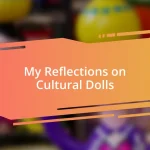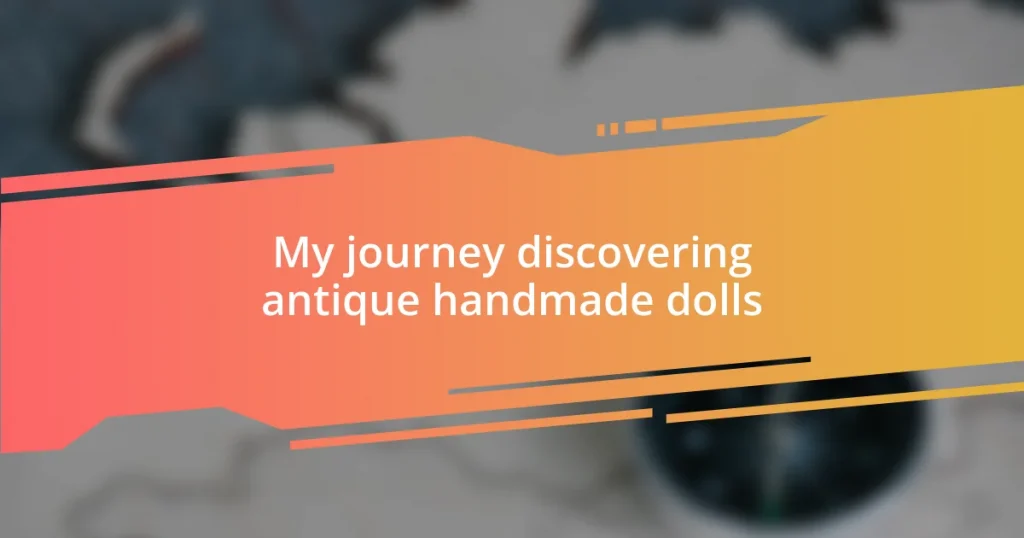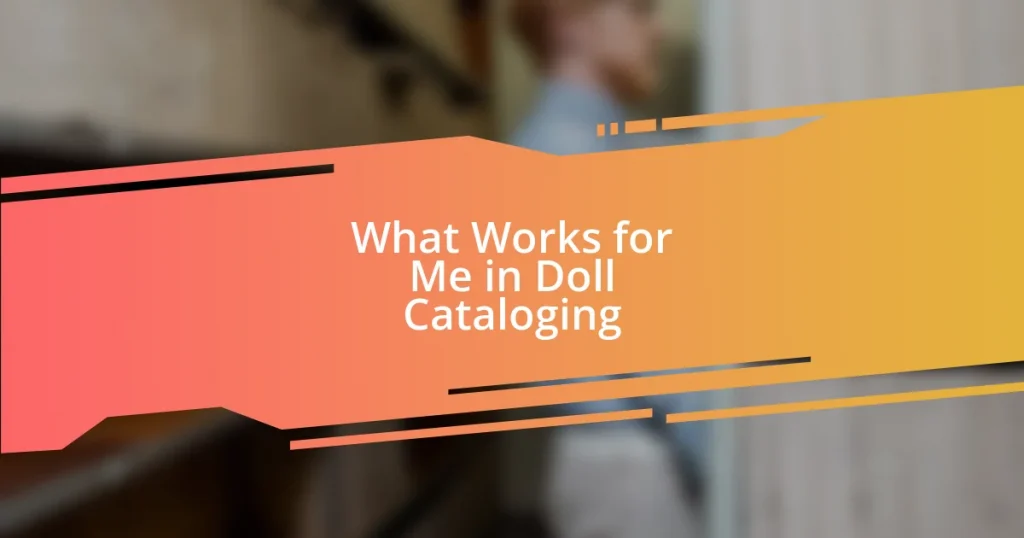Key takeaways:
- Antique and handmade dolls serve as cultural artifacts that reflect the societal values, craftsmanship, and emotional connections of their time.
- Caring for antique dolls involves gentle cleaning, proper storage, and regular inspections to preserve their history and appearance.
- Building a doll collection is enhanced through setting intentions, community networking, and utilizing resources like books and online forums for knowledge sharing.

Introduction to Antique Dolls
Antique dolls hold a fascinating place in history, acting as tiny time capsules that capture the essence of the era in which they were created. I remember the moment I stumbled upon my first antique doll at a quaint little flea market—it was a beautiful porcelain figure, with delicate features that seemed to tell a story of love and craftsmanship from years gone by. Have you ever wondered what stories these dolls could tell if only they could speak?
The charm of antique dolls goes beyond their aesthetic appeal; they often reflect the cultural values and historical contexts of their time. For instance, I was captivated by a 19th-century German doll that showcased the intricate fashion of its age. How incredible is it that a simple doll can connect us to the past, revealing the evolution of styles and societal norms through its very fabric?
As I delved deeper into the world of antique dolls, I found myself enchanted by the uniqueness of each piece. Through their imperfections and wear, they embody the love and care of the hands that once played with them. Isn’t it intriguing to think about all the cherished moments these dolls must have witnessed, hidden away in attics or displayed lovingly on shelves?

Understanding Handmade Dolls
Understanding handmade dolls is like peeling back layers of history. Each doll is a unique creation, often crafted by skilled artisans who pour their heart into every stitch and detail. I remember the thrill of discovering a handmade cloth doll at a local artisan fair. Its softly painted face and colorful patchwork dress told a story of creativity that mass-produced dolls simply can’t replicate.
These dolls vary widely in materials and styles, representing different cultures and traditions. For example, I once came across a beautiful handmade doll from Ecuador, adorned with vibrant textiles. It struck me how this doll conveyed so much about the local weaving techniques and cultural heritage. Handmade dolls not only serve as toys or collectibles but also as cultural artifacts that celebrate human artistry and ingenuity.
I’ve also noticed how handmade dolls evoke deep emotional connections. When I gifted a hand-stitched doll to my niece, her eyes lit up with joy. It made me realize that these dolls possess a soul; they carry the love and intentions of their makers. Isn’t it touching to think about the labor of love that goes into crafting just one doll, creating not just a product but a cherished memory for future generations?
| Characteristic | Handmade Dolls | Mass-Produced Dolls |
|---|---|---|
| Uniqueness | Each is one-of-a-kind, reflecting individual craftsmanship. | Identical designs, lacking individuality. |
| Materials | Natural and varied materials, often eco-friendly. | Synthetic, often less durable materials. |
| Cultural Significance | Reflects specific cultural heritage and traditions. | Generic, lacks specific cultural meaning. |
| Emotional Connection | Often hand-made with love, fostering emotional bonds. | Less personal attachment, seen as mere toys. |

Researching Antique Doll History
Researching the history of antique dolls can be quite a journey, almost like stepping into a time machine. Through various sources, such as books, online archives, and collector societies, I’ve come to appreciate how these charming figures were crafted not just as playthings, but as reflections of societal values of their time. I remember poring over old catalogs and journal entries, feeling a thrill as I imagined the hands that created each doll and the lives they touched.
- Starting with local libraries can uncover astonishing information on regional doll-making traditions.
- Visiting antique shops and flea markets often yields not just dolls, but valuable insights from passionate collectors.
- Joining online forums enables connection with worldwide collectors, enhancing my understanding of dolls’ global histories.
What strikes me most is how each doll carries a narrative—a small reflection of the life and culture it emerged from, often accompanied by fascinating anecdotes from those who cherished them. Each discovery, no matter how small, has enriched my understanding and appreciation for these lovely artifacts.

Identifying Quality Handmade Dolls
When identifying quality handmade dolls, I always start by examining the craftsmanship. I recall one instance where I came across a doll with intricate stitching and carefully sculpted features. It wasn’t just the appearance that caught my eye; it was the energy and attention to detail that resonated. A true handmade doll should feel special in your hands, inviting a closer look at its unique traits.
Materials play a significant role in the quality of handmade dolls, too. I once found a doll made from natural fibers, which felt soft and inviting, unlike the typical synthetic options. I remember wondering, “How does the choice of material reflect the artisan’s values?” I believe that the best dolls not only look appealing but also embody a commitment to sustainability and authenticity.
Finally, I think about the story behind each doll. There’s something deeply personal about knowing a doll has a history, a creator with a vision. One time, I met a doll maker who shared the inspiration behind her creations, and it felt like stepping into her world. This connection is what truly defines quality in handmade dolls. Wouldn’t you agree that finding a doll with a story makes it far more cherished?

Caring for Antique Dolls
Caring for antique dolls requires a gentle touch and an attentive heart. One of my first encounters with an antique doll left a lasting impression. I remember cringing at the thought of using harsh chemicals to clean her delicate porcelain face. Instead, I opted for a soft, damp cloth and a mild soap solution, which restored her beauty without compromising her integrity. It’s amazing how a little patience can make such a difference in preserving the charm of these treasures.
I’ve learned that storage plays a crucial role in the longevity of antique dolls. I remember when I first rescued a lovely cloth doll from a dusty attic. To keep her safe, I placed her in a breathable cotton bag, away from direct sunlight and humidity. This simple step prevented any discoloration or fabric deterioration which could easily happen over time. Have you ever considered how the environment affects your collectibles? I can tell you that I quickly realized that monitoring temperature and humidity levels is just as critical for dolls as it is for fine art.
Regular inspections are another important aspect of caring for antique dolls. I always make it a point to check for loose joints, fading paint, or any signs of wear. Once, during an inspection of a vintage doll, I noticed a tiny tear in her dress. I felt a pang of sadness, but also excitement because it presented an opportunity to lovingly make repairs. I’ve come to view each little imperfection as a chapter in the doll’s story. It’s a reminder that caring for them isn’t just about maintaining their appearance, but also honoring their history. How do you feel when you discover a flaw in something you cherish? I find it a chance to connect deeper with the past, embracing the narratives each doll carries.

Building an Antique Doll Collection
Building an antique doll collection is both an art and a journey. I vividly remember my first flea market visit, where I stumbled upon a charming little doll with a hand-knitted dress. It felt like uncovering a hidden treasure! I had no idea at the time that this moment would ignite a passion for doll collecting that would take me on countless adventures. Have you ever experienced that rush of excitement when you find something truly special?
As my collection grew, I learned the importance of setting intentions for what I wanted to include. Each doll reflects a piece of history and personal significance. Once, I chose to focus on early 20th-century dolls, intrigued by how they mirrored societal changes of the era. It’s fascinating to consider how these dolls once captured the imagination of children from generations past. I often think—what stories are woven into their fabric?
Networking with fellow collectors and attending doll shows has been invaluable for my journey. It’s not just about acquiring dolls; it’s about community. I remember having an enriching conversation with a seasoned collector who shared tips on preservation techniques. Sharing stories and insights with others can enhance your understanding and appreciation of these antiques. Isn’t it incredible how a simple conversation can ignite new ideas and deeper appreciation for our collections?

Resources for Antique Doll Enthusiasts
Finding resources as an antique doll enthusiast can truly enhance your collecting experience. One site that I frequently recommend is The Doll Connection, where I’ve found a wealth of information including articles on identification and restoration tips. Have you ever noticed how sharing insights can create a deeper connection to your pieces? I remember reading about a rare doll type and suddenly spotting one at an estate sale—it felt like a rewarding treasure hunt!
Another gem in the doll collecting world is online forums like Doll Talk, where collectors share their stories, questions, and insights. I recall a moment when a member graciously offered advice on fixing a doll’s chipped paint. It’s heartwarming to see how passionate people bond over similar interests. How wonderful is it when a fellow enthusiast takes the time to help out another? This community is a treasure trove of knowledge and support, fostering relationships I cherish deeply.
Books can also be an invaluable resource. I often recommend “The Collector’s Guide to Antique Dolls,” which has become my go-to reference. During one tender afternoon, I dove into its pages, uncovering the backstory of a beloved doll in my collection. Isn’t it intriguing how a single book can transform your understanding of a cherished piece? Each page turned adds layers to our appreciation, allowing us to cherish the dolls not just as artifacts but as stories waiting to be told.















